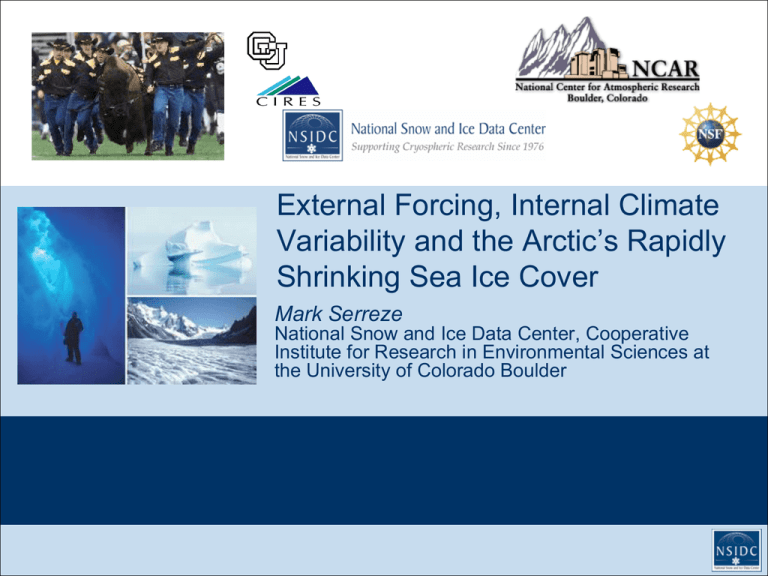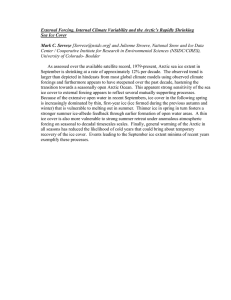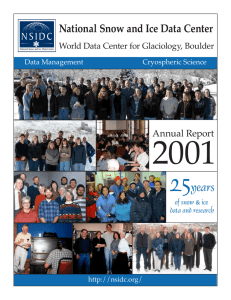External Forcing, Internal Climate Variability and the Arctic’s Rapidly Mark Serreze
advertisement

External Forcing, Internal Climate Variability and the Arctic’s Rapidly Shrinking Sea Ice Cover Mark Serreze National Snow and Ice Data Center, Cooperative Institute for Research in Environmental Sciences at the University of Colorado Boulder The National Snow and Ice Data Center (NSIDC) The view from NSIDC The National Snow and Ice Data Center… Manages and distributes scientific data Performs scientific research Supports data users Creates tools for data access Educates the public about the cryosphere The Arctic sea ice cover AMSR-E data, plots by Univ. Bremen End of summer ice extent is rapidly declining Sept 16, 2007: Sept 14, 2008: Sept 12, 2009: Sept 19, 2010: 4.13 million sq. km 4.51 million sq. km 5.10 million sq. km 4.60 million sq. km Sept 11, 2011: 4.34 million sq. km Left: Univ. Bremen; Right: Updated from Stroeve et al. (2007); Top: NSIDC Conservative models and large between-model scatter Updated from Stroeve et al. (2007) Arctic warming and ice-albedo feedback Cumulative anomalies in absorbed solar radiation, 2005-2010, based on JRA-25 From Stroeve et al., 2011 JRA-25 925 hPa temperature anomalies, 1979-2010 Black carbon aerosols newsbusters.org With the advent of cleaner combustion techniques, sulfate aerosol concentrations have declined, but black carbon aerosol concentrations have increased, largely because of increasing emissions from Asia. In contrast to sulfate aerosols, black carbon aerosols strongly absorb solar radiation and hence have a warming effect on the atmosphere. Results from the modeling study of Shindell and Faluvegi (2009) suggest that the combination of decreasing concentrations of sulfate aerosols and increasing concentrations of black carbon aerosols in the Arctic has contributed to Arctic warming over the past three decades. ALSO – soot on snow. Clouds and atmospheric energy transport Francis and Hunter (2006): Increased spring cloud cover, more abundant water containing clouds and increased water vapor have augmented to the downward longwave flux to the surface, contributing to retreat of the sea ice margin. Graversen et al. (2008), Yang et al. (2010): Links between recent temperature change and altered atmospheric energy transport. http://campaign.arm.gov/altos/ A puzzle: enhanced Atlantic inflow Moorings at Svinoy and Fram Strait I. Polyakov et. al, 2005 The “dipole” circulation of summer 2007 High pressure over central Arctic Ocean Low pressure over Siberia A very warm Arctic NCEP/NCAR Reanalysis; NOAA/ESRL Physical Sciences Division Observed autumn temperature trends, 1960-2010 GISS Analysis Effects of sea ice loss •Ocean picks up more heat in summer •Releases more heat back to the atmosphere in autumn and winter •Albedo feedback signal on temperature is seasonally delayed Increasing tropospheric water vapor MERRA anomalies by month and year for the polar cap (the region north of 70 deg. N) of a) surface to 500 hPa precipitable water; b) 850 hPa air temperature; c) 850 hPa specific humidity; d) 850 hPa relative humidity. Anomalies are with respect to 1979-2008 means. A complex set of interconnected processes Warmer air temperatures in all seasons (GHG forcing) Enhanced ice-albedo feedback More open water in September Warmer autumn temperatures Earlier development of open water Thinner spring ice Adapted from Stroeve et al., 2011 Will sea ice loss affect circulation patterns? The NCAR Community Atmospheric Model (CAM) was used to perform two 30-year simulations, one with a climatological late 20th century seasonal cycle in sea ice fraction, and one using the 2007 seasonal cycle. Circulation differences were most prominent in autumn and winter. E. Cassano, J. Cassano and M. Higgins Conclusions We are quickly losing the ice cover •Impacts are already being felt Ice-free summers by 2030? Earlier? •We seem to be in the fast lane Both external forcing and internal variability are at work •Atmospheric circulation patterns – dipole anomaly •Ocean heat flux convergence •Atmospheric heat flux convergence •Black carbon aerosols and soot on snow •Cloud cover and water vapor Thank You




